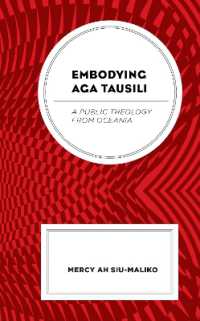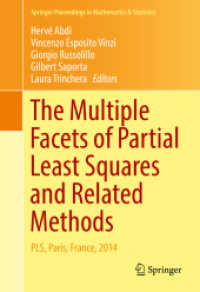- ホーム
- > 洋書
- > 英文書
- > Literature / Classics
Full Description
The Buildings is a sixth-century text by Prokopios of Kaisareia (Caesarea Maritima) on the building works attributed to the eastern Roman emperor Justinian I (r. 527-565 CE), extolling the virtues of good rulership through praise of architecture. Book I centres on the imperial capital Constantinople: rich in its use of rhetoric and aesthetics, it portrays the emperor as a builder-patron, but also portrays the city itself as a place of beauty and delight to its inhabitants. Several of the buildings described in Book I - such as Hagia Sophia - are extant today; they and others are also documented in a range of historical sources that allow us to compare Prokopios's account with his contemporaries, and to observe the legacy and changing uses of the spaces he describes into the Middle Ages.
Fashioning Sixth-Century Constantinople presents an all-new English translation of Book I paired with a revised edition of the Greek text. It is accompanied by a detailed interdisciplinary commentary, informed by the respective disciplines of philology, history, archaeology and art history, but bringing a new perspective through cross-disciplinary collaboration, especially on points of technical and topographical descriptions, aiming at the most comprehensive and up-to-date commentary of the text.
This book will appeal to scholars and students of Byzantine literature, history, art, and archaeology, as well as those interested in the florescence of Byzantine Constantinople.
This volume originates in the DFG-funded project 'Procopius and the Language of Buildings' (2018-2022), hosted by the Universities of Mainz and Halle-Wittenberg.
Contents
Foreword and Introduction
Foreword
Note on the Edition
Main manuscripts used for this edition
Note on the Translation
Note on the Archaeological Commentary
Introduction
Procopius's Buildings: Significance to Scholarship
Constantinople
Constantinople and Justinian: Context and Image
Imperial Patronage in Constantinople: Norms and Practices
Other Texts on Justinian's Constructions in Constantinople
Reconstructing Late Antique Constantinople through Archaeology: Historical Development and Methods
Procopius's Biography and His Relation to Constantinople
The Text of the Buildings as a Historical Artifact
The Date of the Buildings
The Textual Transmission: Manuscripts, Abridgement and Extracts
The Byzantine Afterlife of the Buildings
Early modern reception of the Buildings: editions and translations before Haury
The Text as Literary Object
The Procopian Matrix: Style, Narrative and Genre
Composition: Macro and Microstructures, Motifs, and Themes
Buildings Classification
A Brief Note on Orientation
Maps and Plans
Text and translation of the Buildings and chapter-by-chapter commentary
Preface: rhetorical and historical exordium, Justinian's military, legal and religious achievements, and delayed reveal of the subject (1.1.1-19)
Hagia Sophia: historical context, design elements - focus on the central space (1.1.20-49)
Hagia Sophia: description of interior features - focus on the rest of the church (1.1.50-66)
Hagia Sophia: two episodes of Justinian's personal intervention (1.1.67-78)
The Column of Justinian (1.2.1-12)
Hagia Eirene and the hospices of the Patriarchate (1.2.13-19)
The churches of the Virgin Mary at Blachernai, Pege and elsewhere in the city and its environs; the churches of Anne, Zoe, and the Archangel Michael in the city (1.3)
The churches dedicated to the Apostles: SS. Peter and Paul in the Palace of Hormisdas and the church of SS. Sergius and Bacchus (1.4.1-8)
The Church of the Holy Apostles: description and discovery of the relics (1.4.9-24)
The churches dedicated to the martyrs Acacius, Plato, Mocius, Thyrsus, Theodore, Thecla and Theodota (1.4.25-31)
Constantinople's maritime topography (1.5)
The churches on the Golden Horn: SS. Priscus and Nicholas, SS. Cosmas and Damian, and St Anthimus (1.6.1-14)
St Irene at Sykai, the Forty Martyrs and Justinian's miraculous healing (1.7)
The churches on either side of the Bosporus: the churches of the Archangel Michael at Anaplous and Brochoi/Proochthoi, and a church of Mary near the latter (1.8)
The Metanoia convent (1.9.1-10)
The churches of the upper Bosporus (St Panteleimon, the Argyronion leprosarion, Archangel Michael at Mochadion) and more in the city (St Tryphon, SS. Menas and Menaios and St Ia) (1.9.11-18)
The Augoustaion area: the Baths of Zeuxippos and the Senate House (1.10.1-9)
The Chalke Gate (1.10.10-20)
Arkadianai: description of the court and statue of Theodora (1.11.1-9)
The water supply of the city and the Basilica Cistern (1.11.10-15)
The harbours and suburban palaces at Hiereia and Joukoundianai (1.11.16-22)
End of the section on Constantinople; the hospice at Stadion (1.11.23-27)
The Great Palace at the time of Justinian
Textual Sources for the Great Palace
Archaeological Evidence for the Great Palace
The Topographical Context of the Great Palace
A Reconstruction of the Layout and Internal Organisation of the Great Palace
Gates of the Great Palace
Conclusion
Bibliography
List of Editions of the Buildings in Chronological Order
List of Abbreviations
Primary Sources
Secondary Works








